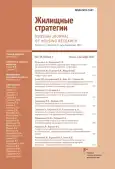Strategy of construction innovatization: economic and legal characteristics of housing quality
- Authors: Gorodnova N.V.1, Zhevnyak O.V.1
-
Affiliations:
- Ural Federal University named after the First President of Russia B.N. Yeltsin
- Issue: Vol 10, No 3 (2023)
- Pages: 257-278
- Section: Articles
- URL: https://journals.eco-vector.com/2410-1621/article/view/608155
- DOI: https://doi.org/10.18334/zhs.10.3.118834
- ID: 608155
Cite item
Abstract
In the world practice of the development of large cities, the concept of Smart City is successfully implemented. It aims at achieving a new quality of life, improving the efficiency of urban development facilities, and applying end-to-end technology in the design and construction of residential real estate. The research purpose was to identify economic and legal factors for assessing the quality of residential premises in the process of construction innovatization in the Russian Federation.The authors substantiate a new methodological approach to the transformation of housing strategies and the paradigm shift of Russia's economic development. A model of the residential real estate market in conditions of sustainable development is presented. Assessment of the economic development of the residential real estate market for the period up to 2030 is given. The world and Russian experience of applying innovation at various stages of the construction cycle is systematized. The development of the conceptual and categorical apparatus of innovation in the investment and construction sector is proposed. Based on the judicial practice of Russia, the definition of luxury and substitute housing has been clarified.The results obtained can be useful to representatives of the public authorities and private business, the expert and scientific community, whose professional interests include the introduction of information technology as a factor in improving the quality of life in large cities, specialists in the investment and construction sector, as well as practicing lawyers.
About the authors
Natalya Vasilevna Gorodnova
Ural Federal University named after the First President of Russia B.N. Yeltsin
Email: n.v.gorodnova@urfu.ru
Oksana Viktorovna Zhevnyak
Ural Federal University named after the First President of Russia B.N. Yeltsin
Email: zevnyak@mail.ru
References
- Безделева И.В. Влияние цифровых технологий на рынок жилой недвижимости Российской Федерации // Инновации и инвестиции. – 2020. – № 1. – c. 275-276.
- Берлизев Р.Н., Борисова К.С. Рынок жилой недвижимости в условиях цифровой экономики // Экономика и бизнес: теория и практика. – 2021. – № 9-1 (79). – c. 33-36. – doi: 10.24412/2411-0450-2021-9-1-33-36.
- Водянников М.В., Анисимов А.Ю. Тенденции развития рынка жилищного строительства // Жилищные стратегии. – 2023. – № 2. – c. 137-148. – doi: 10.18334/zhs.10.2.117773.
- Данилина Н.В. Применение BIM-технологий на стадии градостроительного проектирование // Промышленное и гражданское строительство. – 2018. – № 9. – c. 48-54.
- Димитриенко И.А., Яковлева Ю.С., Гойхер О.Л. Оценка влияния транспортной стратегии на строительную отрасль и жилищную инфраструктуру // Жилищные стратегии. – 2023. – № 2. – c. 149-166. – doi: 10.18334/zhs.10.2.117822.
- Ильвицкая С.В., Лобкова Т.В. «Зелёная» архитектура жилища и Green BIM технологии // Архитектура и строительство России. – 2018. – № 1. – c. 108-113.
- Казарбин А.В., Лунина Ю.В. Рынок жилой недвижимости как фактор социально-экономического развития Хабаровского края // Дальний Восток: проблемы развития архитектурно-строительного комплекса. – 2019. – № 1-3. – c. 325-329.
- Крупкин А.В. Развитие концепции «Smart City» в условиях устойчивой экономики // Дискуссия. – 2018. – № 2. – c. 30-36.
- Матвеева Е.С. Рынок жилой недвижимости г. Казани: целевые ориентиры застройщиков и потребительские предпочтения // Жилищные стратегии. – 2022. – № 4. – c. 353-376. – doi: 10.18334/zhs.9.4.116426.
- Пищулев А.А., Блинкова Е.В., Макарова Ш.Н. Повышение качества бетонных работ путем применения полимерных материалов для изготовления индивидуальных опалубочных систем и BIM технологий // Градостроительство и архитектура. – 2018. – № 3. – c. 18-21. – doi: 10.17673/Vestnik.2018.03.4.
- Цыпин И.С., Цыпина С.И. Стратегия развития экономики и промышленности России в условиях международной нестабильности // Экономика. Налоги. Право. – 2019. – № 1. – c. 76-85.
- Эрк А.Ф., Судаченко В.Н., Тимофеев Е.В. Интеллектуальные энергосберегающие технологии с использованием возобновляемых источников энергии // Технологии и технические средства механизированного производства продукции растениеводства и животноводства. – 2019. – № 98. – c. 247-257.
- Boriskina Yu.I. Digital and online technology changing the real estate market in Russia // Real Estate Economics, Management. – 2021. – № 2 (2). – p. 34-38.
- Marzouk M., Azab S., Metawie M. BIM-based approach for optimizing life cycle costs of sustainable building // Journal of Cleaning Production. – 2018. – № 188. – p. 217-226. – doi: 10.1016/j.jclepro.2018.03.280.
- Pruskova K., Kaiser J. Implementation of BIM Technology into the Design Process Using the Scheme of BIM Execution Plan // IOP Conf. Series: Materials Science and Engineering. – 2019. – № 471. – p. 022019. – doi: 10.1088/1757-899X/471/2/022019.
- Wei Li Application of BIM technology in construction bidding. / 1st International Global on Renewable Energy and Development (IGRED 2017). IOP Publishing IOP Conf. Series: Earth and Environmental Science. No. 100 (012 178)., 2017. – 1-4 p.
- Zhou H., Sun J., Wu Y., Chen H. Research on BIM Application in Construction Based on the Green Building Idea // International Conference on Humanities and Advanced Education Technology (ICHAET 2018). 2018. – p. 705-708.
Supplementary files











